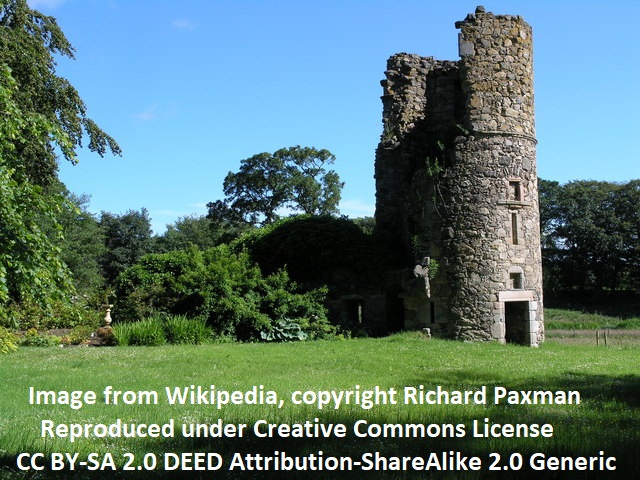Asloun Castle

Asloun Castle Details
Asloun Castle, ruins of C16/17 tower house of the Calders and later, Forbeses, in private garden
- Closest To: Alford
- Access: S.O.A.C. Public Access
- Grid Reference: NJ542149
Asloun Castle is the fragmentary surviving part of a tower house overlooking the Strow Burn, a tributary of the River Don just upstream of Alford, and overlooked by higher ground. The remains consist of a round tower and short section of wall extending to the northwest from it, and are within private garden grounds. The tower contains a doorway, tall slit windows, and two empty niches for heraldic panels, above these is a ratline and a third storey. Early plans show that the tower was attached to one corner of a rectangular residential block, and presume a diagonally opposed round tower, for which there is no surviving evidence. Architecturally the mouldings of door and windows point towards a late 16th/early 17th century date of construction, and within this period an earlier date is to be preferred because of the vague evidence for a vaulted basement.
There is not much history associated with Asloun. Robert Calder of Asloun is mentioned in 1496. John Calder of Asloun and his (third) son Patrick are mentioned in a document of 1577, and the John Calder who was the husband of Elizabeth Forbes of Towie who witnessed a document in 1549, the John Calder who exchanged lands with John Forbes of Towie in 1562, and the John Calder who was targeted by the Earl of Huntly in 1568 all seem likely to both be the same man. Alexander Calder of Asloun is mentioned in 1615 and 1617, and was presumably John’s elder son. However, in 1641 John Forbes is named as laird of Asloun, and Robert Forbes in 1653, indicating that the Calders had moved on or otherwise lost the estate. This happened in 1625, when James Calder of Asloun assigned the reversion of the estate to John Forbes of Balnagask, the second son of the laird of Balfluig. The night before the Battle of Alford in July 1645, the Marquis of Montrose spent a night at Asloun, which is the only time that the castle appears to have appeared in national affairs. In time, Asloun passed to a younger son of the Lords Forbes, at which point it seems to have declined in importance, and was passed around various members of the Forbes family. On Roy’s map, “C. Ashlune” is noted, but by 1822 it is just noted as “Alstoon” suggesting that it had fallen into disrepair by this time, or else had been replaced by a more suitable house.
Become a supporter of my work to access a more detailed history